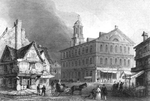Green Dragon Tavern
1697 establishments in Massachusetts1828 disestablishmentsBuildings and structures demolished in 1832Demolished buildings and structures in BostonFormer pubs ... and 3 more
North End, BostonTaverns in MassachusettsTaverns in the American Revolution

The Green Dragon Tavern was a public house located on Union Street (then known as Green Dragon Lane) in Boston's North End. A popular meeting place for both the Freemasons and the Sons of Liberty, it was demolished in 1832.
Excerpt from the Wikipedia article Green Dragon Tavern (License: CC BY-SA 3.0, Authors, Images).Green Dragon Tavern
Union Street, Boston
Geographical coordinates (GPS) Address Nearby Places Show on map
Geographical coordinates (GPS)
| Latitude | Longitude |
|---|---|
| N 42.360919444444 ° | E -71.056922222222 ° |
Address
Union Street 23,25,27
02109 Boston
Massachusetts, United States
Open on Google Maps







